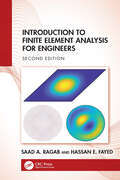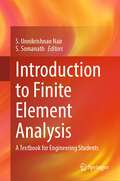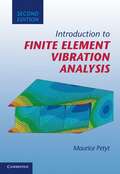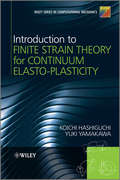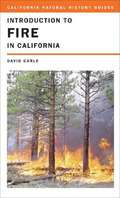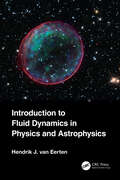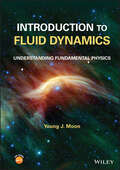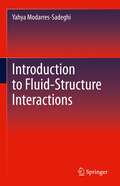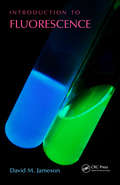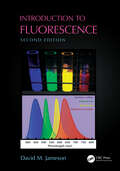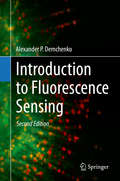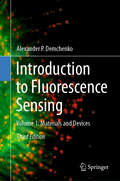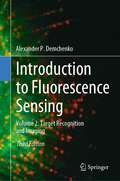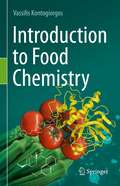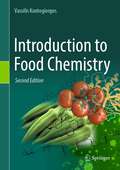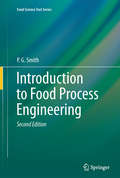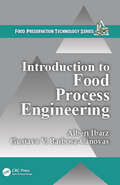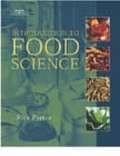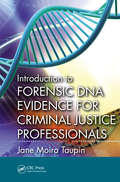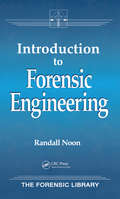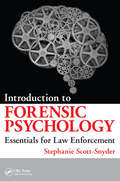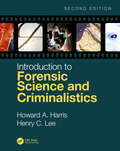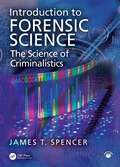- Table View
- List View
Introduction to Finite Element Analysis for Engineers
by Saad A. Ragab Hassan E. FayedNow in its second edition, Introduction to Finite Element Analysis for Engineers is an essential introduction to FEA as a method to solve differential equations. With many practical examples focusing on both solid mechanics and fluid mechanics, it includes problems for both applications.Using a structure of classes of differential equations, the book also includes MATLAB® codes and aims to build a comprehensive understanding of FEA and its applications in modern engineering. New chapters present finite-element models of a system of partial differential equations in two or more independent variables typified by problems in theory of elasticity and plates. Chapter ten presents the finite element method for a nonlinear Mindlin-Reissner plate, and panel flutter is included as a typical example of fluid-structure interactions. The book demonstrates the power and versatility of FEA as a tool with a large number of examples of practical engineering problems. These problems range from those which can be solved without a computer, to those requiring MATLAB® or Python.With applications in civil, mechanical, aerospace, and biomedical engineering, the textbook is ideal for senior undergraduate and first-year graduate students and also aligns with mathematics courses.
Introduction to Finite Element Analysis: A Textbook for Engineering Students
by S. Unnikrishnan Nair S. SomanathThis textbook covers the basic concepts and applications of finite element analysis. It is specifically aimed at introducing this advanced topic to undergraduate-level engineering students and practicing engineers in a lucid manner. It also introduces a structural and heat transfer analysis software FEASTSMT which has wide applications in civil, mechanical, nuclear and automobile engineering domains. This software has been developed by generations of scientists and engineers of Vikram Sarabhai Space Centre and Indian Space Research Organisation. Supported with many illustrative examples, the textbook covers the classical methods of estimating solutions of mathematical models. The book is written in an easy-to-understand manner. This textbook also contains numeral exercise problems to aid self-learning of the students. The solutions to these problems are demonstrated using finite element software. Furthermore, the textbook contains several tutorials and associated online resources on usage of the FEASTSMT software. Given the contents, this textbook is highly useful for the undergraduate students of various disciplines of engineering. It is also a good reference book for the practicing engineers.
Introduction to Finite Element Vibration Analysis
by Maurice PetytThis is an introduction to the mathematical basis of finite element analysis as applied to vibrating systems. Finite element analysis is a technique that is very important in modeling the response of structures to dynamic loads. Although this book assumes no previous knowledge of finite element methods, those who do have knowledge will still find the book to be useful. It can be utilised by aeronautical, civil, mechanical, and structural engineers as well as naval architects. This second edition includes information on the many developments that have taken place over the last twenty years. Existing chapters have been expanded where necessary, and three new chapters have been included that discuss the vibration of shells and multi-layered elements and provide an introduction to the hierarchical finite element method.
Introduction to Finite Strain Theory for Continuum Elasto-Plasticity
by Yuki Yamakawa Koichi HashiguchiComprehensive introduction to finite elastoplasticity, addressing various analytical and numerical analyses & including state-of-the-art theoriesIntroduction to Finite Elastoplasticity presents introductory explanations that can be readily understood by readers with only a basic knowledge of elastoplasticity, showing physical backgrounds of concepts in detail and derivation processes of almost all equations. The authors address various analytical and numerical finite strain analyses, including new theories developed in recent years, and explain fundamentals including the push-forward and pull-back operations and the Lie derivatives of tensors.As a foundation to finite strain theory, the authors begin by addressing the advanced mathematical and physical properties of continuum mechanics. They progress to explain a finite elastoplastic constitutive model, discuss numerical issues on stress computation, implement the numerical algorithms for stress computation into large-deformation finite element analysis and illustrate several numerical examples of boundary-value problems. Programs for the stress computation of finite elastoplastic models explained in this book are included in an appendix, and the code can be downloaded from an accompanying website.
Introduction to Fire in California
by David CarleCarle covers the basics of fire ecology; looks at the effects of fire on wildlife, soil, water, and air; discusses firefighting organizations and land management agencies; explains current policies; and explores many other topics.
Introduction to Fluid Dynamics in Physics and Astrophysics
by Hendrik Jan van EertenThis textbook provides an accessible and self-contained introduction to the physics behind fluid dynamics; exploring the laws of nature describing three out of four fundamental states of matter (liquids, gases, and plasmas). Based on years of teaching of fluid dynamics theory and computation at advanced undergraduate level, it provides readers with the tools to understand and model fluid dynamical systems across a wide range of applications, from dense liquids to dilute space plasmas. The book covers the principles of fluid dynamics for an audience without prior exposure to fluid dynamics specifically. Discussion of relevant vector algebra, thermodynamics and electromagnetism is included, to ensure that the book is accessible both to readers experienced in these topics and readers starting from a basic understanding. Example applications are drawn both from astrophysics and physics, touching upon topical research such as relativistic blast waves from neutron star mergers and the implications of plasma nature of the atmosphere for present and future radio observatories. These are contrasted and complemented with examples from general physics (e.g. contrasting the incompressible nature of water with the dilute interstellar medium). It is an ideal textbook for advanced undergraduates studying the topic and will provide a solid foundation for further (postgraduate) studies into fluid dynamics in physics or astrophysics. Key Features: Introduction to fluid dynamics pitched at advanced undergraduate level, accessible to students who are still learning relevant mathematical techniques Includes over 60 exercises and selected worked solutions, in addition to timely examples and easily accessible numerical demonstrations written in C and python for readers to experiment with (https://github.com/hveerten/code_fluid_dynamics_book) Up-to-date selection of topics including fluid dynamics in special relativity and computational fluid dynamics, written by an expert in the field. The book covers all that is needed to independently write a finite-volume solver for Euler’s equations and/or reproduce the provided Python and C software Covers a wide range of applications in astrophysics, including first-order Fermi acceleration in shocks, accretion discs, self-similarity in cosmic explosions and interstellar turbulence
Introduction to Fluid Dynamics: Understanding Fundamental Physics
by Young J. MoonINTRODUCTION TO FLUID DYNAMICS A concise resource that presents a physics-based introduction to fluid dynamics and helps students bridge the gap between mathematical theory and real-world physical properties Introduction to Fluid Dynamics offers a unique physics-based approach to fluid dynamics. Instead of emphasizing specific problem-solving methodologies, this book explains and interprets the physics behind the theory, which helps mathematically-inclined students develop physical intuition while giving more physically-inclined students a better grasp of the underlying mathematics. Real-world examples and end-of-chapter practice problems are included to further enhance student understanding. Written by a highly-qualified author and experienced educator, topics are covered in a progressive manner, enabling maximum reader comprehension from start to finish. Sample topics covered in the book include: How forces originate in fluids How to define pressure in a fluid in motion How to apply conservation laws to deformable substances How viscous stresses are related to strain rates How centrifugal forces and viscosity play a role in curved motions and vortex dynamics How vortices and centrifugal forces are related in external viscous flows How energy is viscously dissipated in internal viscous flows How compressibility is related to wave and wave speed Students and instructors in advanced undergraduate or graduate fluid dynamics courses will find immense value in this concise yet comprehensive resource. It enables readers to easily understand complex fluid phenomena, regardless of the academic background they come from.
Introduction to Fluid-Structure Interactions
by Yahya Modarres-SadeghiThis timely book introduces the subject of Fluid-Structure Interactions (FSI) to students and professionals. It discusses the major ideas in FSI with the goal of providing the fundamental understanding to the readers who possess limited or no understanding of the subject. The author presents the physics of the problem, rather than focusing on the methods, and discusses the essential methods of analysis. The principle goal of Introduction to Fluid-Structure Interactions is impart to students and practitioner a physical understanding of major topics in fluid-structure interactions: axial flow problems (when the direction of the flow is parallel to the long axis of the structure) and crossflow problems (when the direction of the flow is normal to the long axis of the structure). Facilitating readers’ understanding of both categories, starting with simple 1 DOF systems and continuing to more complicated continuous flexible structures, Introduction to Fluid-Structure Interactions, is ideal for graduate students and practitioners interested in this critical field.Stands as a unique introductory volume to study Fluid-Structure Interactions (FSI);Covers aspects of FSI relevant to Fluid Mechanics, Wind Energy, Ocean Engineering, and Biomedical research;Integrates most recent findings from research on FSI;Emphasizes the physics behind the phenomena in detail;Maximizes readers understanding by beginning with fundamental concepts and developing focus to more complex systems.
Introduction to Fluorescence
by David M. JamesonIn color throughout, this text helps readers acquire a sound understanding of basic fluorescence theory and practice. It takes them through the history of important discoveries to the most current advances. The author introduces the fundamentals of the fluorescence phenomenon and gives detailed examples of fluorescence applications in the molecular life sciences, including biochemistry, biophysics, clinical chemistry and diagnostics, pharmaceutical science, and cell and molecular biology. The text includes references in each chapter, more than 250 figures, and the chemical structures of the most widely used fluorescent molecules.
Introduction to Fluorescence
by David M. JamesonThe phenomenon known as ‘fluorescence’ is now widely used in the chemical, physical and life sciences largely due to the development of highly sophisticated fluorescent probe chemistries and the commercial availability of these probes as well as the development of novel microscopy approaches. This Second Edition of Introduction to Fluorescence helps readers acquire a thorough understanding of basic fluorescence theory and practice. It describes the general principles in a direct way and uses examples from a variety of disciplines to demonstrate them. Since the First Edition, significant advances in the field have appeared. For example, phasors, both lifetime and spectral phasors, have become very popular, and so a new chapter dedicated to this topic has been added in this edition. Furthermore, significant advances have been made in fluorescence microscopy methods, including super-resolution and single-molecule techniques.In color throughout, the book takes readers through the history of important discoveries to the most current advances. It introduces the fundamentals of the fluorescence phenomenon and gives detailed examples of fluorescence applications in the molecular life sciences, including biochemistry, biophysics, clinical chemistry and diagnostics, pharmaceutical science, and cell and molecular biology. The author presents the basic theories underlying the applications and offers in-depth information on practical aspects.Numerous references are given in each chapter, along with a list of particularly important references at the end of each chapter. The text incorporates more than 340 figures that clearly illustrate the concepts and gives the chemical structures of the most widely used fluorescent molecules. In addition, Chapter 13, the Appendix, provides a "Rogue’s Gallery" of the most common errors and pitfalls to avoid.
Introduction to Fluorescence Sensing
by Alexander P. DemchenkoFluorescence is the most popular technique in chemical and biological sensing and this book provides systematic knowledge of basic principles in the design of fluorescence sensing and imaging techniques together with critical analysis of recent developments. Its ultimate sensitivity, high temporal and spatial resolution and versatility enables high resolution imaging within living cells. It develops rapidly in the directions of constructing new molecular recognition units, new fluorescence reporters and in improving sensitivity of response, up to the detection of single molecules. Its application areas range from the control of industrial processes to environmental monitoring and clinical diagnostics. Being a guide for students and young researchers, it also addresses professionals involved in basic and applied research. Making a strong link between education, research and product development, this book discusses prospects for future progress.
Introduction to Fluorescence Sensing: Volume 1: Materials and Devices
by Alexander P. DemchenkoThis book provides systematic knowledge of basic principles in the design of fluorescence sensing and imaging techniques together with critical analysis of recent developments. Fluorescence is the most popular technique in chemical and biological sensing because of its ultimate sensitivity, high temporal and spatial resolution and versatility that enables imaging within the living cells. It develops rapidly in the directions of constructing new molecular recognition units, new fluorescence reporters and in improving sensitivity of response up to detection of single molecules. Its application areas range from control of industrial processes to environment monitoring and clinical diagnostics. Being a guide for students and young researchers, it also addresses professionals involved in active basic and applied research. Making a strong link between education, research and product development, this book discusses prospects for future progress.
Introduction to Fluorescence Sensing: Volume 2: Target Recognition and Imaging
by Alexander P. DemchenkoFluorescence is the most popular technique in chemical and biological sensing because of its ultimate sensitivity, high temporal and spatial resolution and versatility that enables imaging within the living cells. It develops rapidly in the directions of constructing new molecular recognition units, new fluorescence reporters and in improving sensitivity of response up to detection of single molecules. Its application areas range from control of industrial processes to environment monitoring and clinical diagnostics. This book provides systematic knowledge of basic principles in design of fluorescence sensing and imaging techniques together with critical analysis of recent developments. Being a guide for students and young researchers, it also addresses professionals involved in active basic and applied research. Making a strong link between education, research and product development, this book discusses prospects for future progress.
Introduction to Food Chemistry
by Vassilis KontogiorgosThe complexity of food chemistry makes it a challenging subject for students studying in a food science course. Although there are excellent food chemistry books available in the market they have two major flaws: they are either encyclopedic or they are not pitched correctly to undergraduate food science students. The first problem creates difficulties for students to identify what is important and how much they need to know. The second problem arises when the book is written by authors that are not food scientists (e.g., chemists), they are not academics that are engaged with teaching or they are not sufficiently qualified to teach. In this case, it is difficult to find links between the chemistry of foods and its relevance to applications or, quite frequently, future employment prospects of the student. Introduction to Food Chemistry bridges this gap in the relevant literature, as it employs the latest pedagogical theories in textbook writing to present the subject to students with broad range of cognitive skills. This book presents specific learning objectives for each chapter and is self-contained so students will not need to search for essential information outside the textbook. To support learning, the book has:Didactic elements with information being conveyed with 3D-figures, color-coded schemes and graphs, annotations on figures that link it to the text descriptionsBuilt-in pedagogy and learning activities at the end of each chapter that are linked to the learning objectives.Keywords and concepts for online search to instigate curiosity for further studies.Conversational writing style without losing academic rigorTo support lecturers, the book has:Helps focus teaching preparation on key aspects of food chemistry relevant to both industry and modern research.Aids the preparation of exams, assignments and other types of assessment or learning activities.For lecturers in search of a singular source to aid in their introductory food chemistry courses, look no further than Introduction to Food Chemistry.
Introduction to Food Chemistry
by Vassilis KontogiorgosThe complexity of food chemistry makes it a challenging subject for students studying in a food science course. Although there are excellent food chemistry books available in the market they have two major flaws: they are either encyclopedic or they are not pitched correctly to undergraduate food science students. The first problem creates difficulties for students to identify what is important and how much they need to know. The second problem arises when the book is written by authors that are not food scientists (e.g., chemists), they are not academics that are engaged with teaching or they are not sufficiently qualified to teach. In this case, it is difficult to find links between the chemistry of foods and its relevance to applications or, quite frequently, future employment prospects of the student. Introduction to Food Chemistry, 2nd Edition bridges this gap in the relevant literature, as it employs the latest pedagogical theories in textbook writing to present the subject to students with broad range of cognitive skills. This book presents specific learning objectives for each chapter and is self-contained so students will not need to search for essential information outside the textbook. This new edition has been expanded to include chapters on sweeteners, glass transition, amino acids, proteins for major food commodities and food additives. All of the original chapters have been updated and expanded to include new research and technologies. To support learning, the book has:Didactic elements with information being conveyed with 3D-figures, color-coded schemes and graphs, annotations on figures that link it to the text descriptionsBuilt-in pedagogy and learning activities at the end of each chapter that are linked to the learning objectives.Keywords and concepts for online search to instigate curiosity for further studies.Conversational writing style without losing academic rigorTo support lecturers, the book has:Helps focus teaching preparation on key aspects of food chemistry relevant to both industry and modern research.Aids the preparation of exams, assignments and other types of assessment or learning activities.For lecturers in search of a singular source to aid in their introductory food chemistry courses, look no further than this expanded new edition of Introduction to Food Chemistry.
Introduction to Food Process Engineering
by P. G. SmithThis is a new book on food process engineering which treats the principles of processing in a scientifically rigorous yet concise manner, and which can be used as a lead in to more specialized texts for higher study. It is equally relevant to those in the food industry who desire a greater understanding of the principles of the food processes with which they work. This text is written from a quantitative and mathematical perspective and is not simply a descriptive treatment of food processing. The aim is to give readers the confidence to use mathematical and quantitative analyses of food processes and most importantly there are a large number of worked examples and problems with solutions. The mathematics necessary to read this book is limited to elementary differential and integral calculus and the simplest kind of differential equation.
Introduction to Food Process Engineering (Food Preservation Technology)
by Albert Ibarz Gustavo V. Barbosa-CanovasConsumer expectations are systematically growing, with demands for foods with a number of attributes, which are sometimes difficult for manufacturers to meet. The engineering processes that are needed to obtain top-quality foods are a major challenge due to the diversity of raw materials, intermediates, and final products. As in any other enterpris
Introduction to Food Science
by Rick Parker"Introduction to Food Science" provides an overview of the science of foods, from nutrition and digestion to processing and preservation. The material is based on a thorough, easy-to-follow outline that makes developing a lesson plan simple. Each chapter contains a list of learning objectives that help identify important concepts and key words that are essential to the understanding of the material. Tables, charts, graphs and illustrations are inserted throughout the text, providing quick and understandable access to information. The "student activities" section at the end of each chapter provide opportunities to directly apply material. The text also provides insight into career opportunities for those interested in working within food science industries.
Introduction to Forensic Chemistry
by Kelly M. ElkinsIntroduction to Forensic Chemistry is the perfect balance of testing methods and application. Unlike other competing books on the market, coverage is neither too simplistic, nor overly advanced making the book ideal for use in both undergraduate and graduate courses. The book introduces chemical tests, spectroscopy, advanced spectroscopy, and chromatography to students. The second half of the book addresses applications and methods to analyze and interpret controlled substances, trace evidence, questioned documents, firearms, explosives, environmental contaminants, toxins, and other topics. The book looks at innovations in the field over time including the latest development of new discernible chemical reactions, instrumental tools, methods, and more.
Introduction to Forensic DNA Evidence for Criminal Justice Professionals
by Jane Moira TaupinThe use of DNA profiling in forensic cases has been considered the most innovative technique in forensic science since fingerprinting, yet for those with limited scientific knowledge, understanding DNA enough to utilize it properly can be a daunting task. Introduction to Forensic DNA Evidence for Criminal Justice Professionals is designed for nonscientific readers who need to learn how to effectively use forensic DNA in criminal cases.Written by a forensic scientist world renowned for her expertise in clothing examination, the book provides a balanced perspective on the weight of DNA evidence. Going beyond a simple explanation of the methodology, it arms attorneys and other criminal justice professionals with knowledge of the strengths and limitations of the evidence, including the danger in relying on DNA statistical probabilities in the determination of guilt. The book covers the most common DNA methods used in criminal trials today nuclear DNA short tandem repeat (STR) techniques, mitochondrial DNA, and Y-STR profiling. It helps prosecutors know when to emphasize DNA evidence or proceed with trial in the absence of such evidence. It assists defense lawyers in knowing when to challenge DNA evidence and perhaps employ an independent expert, when to focus elsewhere, or when to secure the advantage of an early guilty plea.By imparting practical and theoretical knowledge in an accessible manner, the book demystifies the topic to help both sides of the adversarial system understand where DNA evidence fits within the context of the case.
Introduction to Forensic Engineering (Forensics Library)
by Randall K. NoonForensic engineering is generally defined as the application of engineering principles and methodology to answer questions of fact that may have legal ramifications. This new book provides an introduction to the science, methodology, and engineering principles involved in the diagnosis of some common types of accidents and failures, such as fires, explosions, automobile accidents, storm damage, industrial accidents, slips and falls, arson, water pipe damage and more. Each chapter stands alone and can be read without reference to the others. The chapters have been written so that non-technical professionals can easily digest the information and immediately apply it. The book will also be useful to technical professionals who are unfamiliar with particular investigative methodology or technical points of interest. Introduction to Forensic Engineering will benefit lawyers, insurance investigators, engineers, and other professionals who must handle investigative and legal aspects of accidents or failures.
Introduction to Forensic Psychology: Essentials for Law Enforcement
by Stephanie Scott-SnyderResearch indicates that there are psychological principles at play in the situations encountered by law enforcement personnel. The book fulfills an important need in the ever-evolving field of criminal justice, providing a working knowledge of forensic psychology and its application to interview strategies, homicide, emotional disturbance, sexual and domestic violence, hostage negotiations, and other situations. It will help law enforcement to understand, interpret, and anticipate behavior, while responding safely and effectively.
Introduction to Forensic Science and Criminalistics, Second Edition
by Henry C. Lee Howard A. HarrisThis Second Edition of the best-selling Introduction to Forensic Science and Criminalistics presents the practice of forensic science from a broad viewpoint. The book has been developed to serve as an introductory textbook for courses at the undergraduate level—for both majors and non-majors—to provide students with a working understanding of forensic science. The Second Edition is fully updated to cover the latest scientific methods of evidence collection, evidence analytic techniques, and the application of the analysis results to an investigation and use in court. This includes coverage of physical evidence, evidence collection, crime scene processing, pattern evidence, fingerprint evidence, questioned documents, DNA and biological evidence, drug evidence, toolmarks and fireams, arson and explosives, chemical testing, and a new chapter of computer and digital forensic evidence. Chapters address crime scene evidence, laboratory procedures, emergency technologies, as well as an adjudication of both criminal and civil cases utilizing the evidence. All coverage has been fully updated in all areas that have advanced since the publication of the last edition. Features include: Progresses from introductory concepts—of the legal system and crime scene concepts—to DNA, forensic biology, chemistry, and laboratory principles Introduces students to the scientific method and the application of it to the analysis to various types, and classifications, of forensic evidence The authors’ 90-plus years of real-world police, investigative, and forensic science laboratory experience is brought to bear on the application of forensic science to the investigation and prosecution of cases Addresses the latest developments and advances in forensic sciences, particularly in evidence collection Offers a full complement of instructor's resources to qualifying professors Includes full pedagogy—including learning objectives, key terms, end-of-chapter questions, and boxed case examples—to encourage classroom learning and retention Introduction to Forensic Science and Criminalistics, Second Edition, will serve as an invaluable resource for students in their quest to understand the application of science, and the scientific method, to various forensic disciplines in the pursuit of law and justice through the court system. An Instructor’s Manual with Test Bank and Chapter PowerPoint® slides are available upon qualified course adoption.
Introduction to Forensic Science: The Science of Criminalistics
by James T. SpencerIntroduction to Forensic Science: The Science of Criminalistics is a textbook that takes a unique and holistic approach to forensic science. This book focuses on exploring the underlying scientific concepts as presented at the introductory college and senior high school levels. Chapters introduce readers to each of the important areas of forensic science, grouping chapters together by discipline and following a logical progression and flow between chapters. This systematically allows students to understand the fundamental scientific concepts, recognize their various applications to the law and investigations, and discern how each topic fits broadly within the context of forensic science.The writing is accessible throughout, maintaining students’ interest – including both science and non-science majors – while inspiring them to learn more about the field. Concepts are demonstrated with numerous case studies and full-color illustrations that serve to emphasize the important ideas and issues related to a particular topic. This approach underscores scientific understanding, allowing the student to go beyond simple rote learning to develop deeper insights into the field, regardless of their scientific background. This book has been extensively classroom-tested to provide the most comprehensive and up-to-date survey of various forensic disciplines and the current state of the science, policies, and best practices. Key features: Presents a wholly new, fresh approach to addressing a broad survey of techniques and evidentiary analyses in the field of forensic science. All concepts – and the underpinnings of forensic practice – are explained in simple terms, using understandable analogies and illustrations to further clarify concepts. Introduces topics that other introductory texts fail to address, including serology, behavioral science, forensic medicine and anthropology, forensic ecology, palynology, zoology, video analysis, AI/computer forensics, and forensic engineering. Highly illustrated with over 1,000 full-color photographs, drawings, and diagrams to further highlight key concepts. Suitable for both high school senior-level instruction and two- and four-year university courses for majors, non-majors, and criminal justice students enrolled in introductory forensic science classes. Support Materials – including an Instructor’s Manual with test bank and chapter PowerPoint lecture slides – are available to professors with qualified course adoption.
Introduction to Fourier Optics (Mcgraw-hill Series In Electrical And Computer Engineering)
by Joseph GoodmanFourier analysis is a ubiquitous tool that has found application to diverse areas of physics and engineering. Goodman focuses on applications in optics, and in particular with applications to diffraction, imaging, optical information processing, holography, and optical communications. Goodman, Introduction to Fourier Optics satisfies the needs of several different types of Physics and Engineering courses. Directed towards both physicists and engineers this text is suitable for audiences focusing on applications of optics. A clear presentation makes this text work well as both a teaching resource and a reference book.
